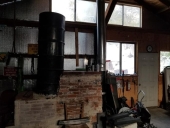posted 8 years ago
No, the floor channel isn't the sole air supply. In fact, all the air is coming in low through the door, exactly at the same level as the floor channel but at a distance of an inch or so. Imagine that the incoming air is icy cold as compared to the interior of the firebox, so this cold air has the tendency to form a puddle in front of the floor channel and the steel threshold. So whatever the door opening is, the floor channel is always served first. The rest of the incoming air is going up and over the threshold.
The primary air and secondary air can't be defined by an opening since the air velocity is radically different in the floor channel as opposed to the main firebox. On top of that, the respective velocities are changing during the burn so the inlet arrangement should be tailored to that phenomenon. My own heater, the red bell, is operated like that. The whole of the air inlet is 22% of the riser csa, at the start the door is open a crack too. When the chimney temperature is rising to 60º C (140º F) I close the door. Rising to 90º C (195º F) I restrict the air inlet to 10% of riser csa, flames in the firebox will get quite lazy but the afterburner flame keep on raging like nothing else. The air velocity in the floor channel is very high, in the firebox just a trickle. As such, the air supply could be implemented as an automated system, steered by the temperature of the chimney as the main parameter.
As you can see, this isn't just a matter of how wide the respective openings are. Based on how much air is supplied by which source and at what air speed. In fact, it's all about volume of air streaming in, where and at which stage of the burn. Level of sophistication is just a step up from the simpler p-channel arrangement. The floor channel is very easy to replace as an added bonus, the very reason why I decided to give it a go.

























 1
1


























